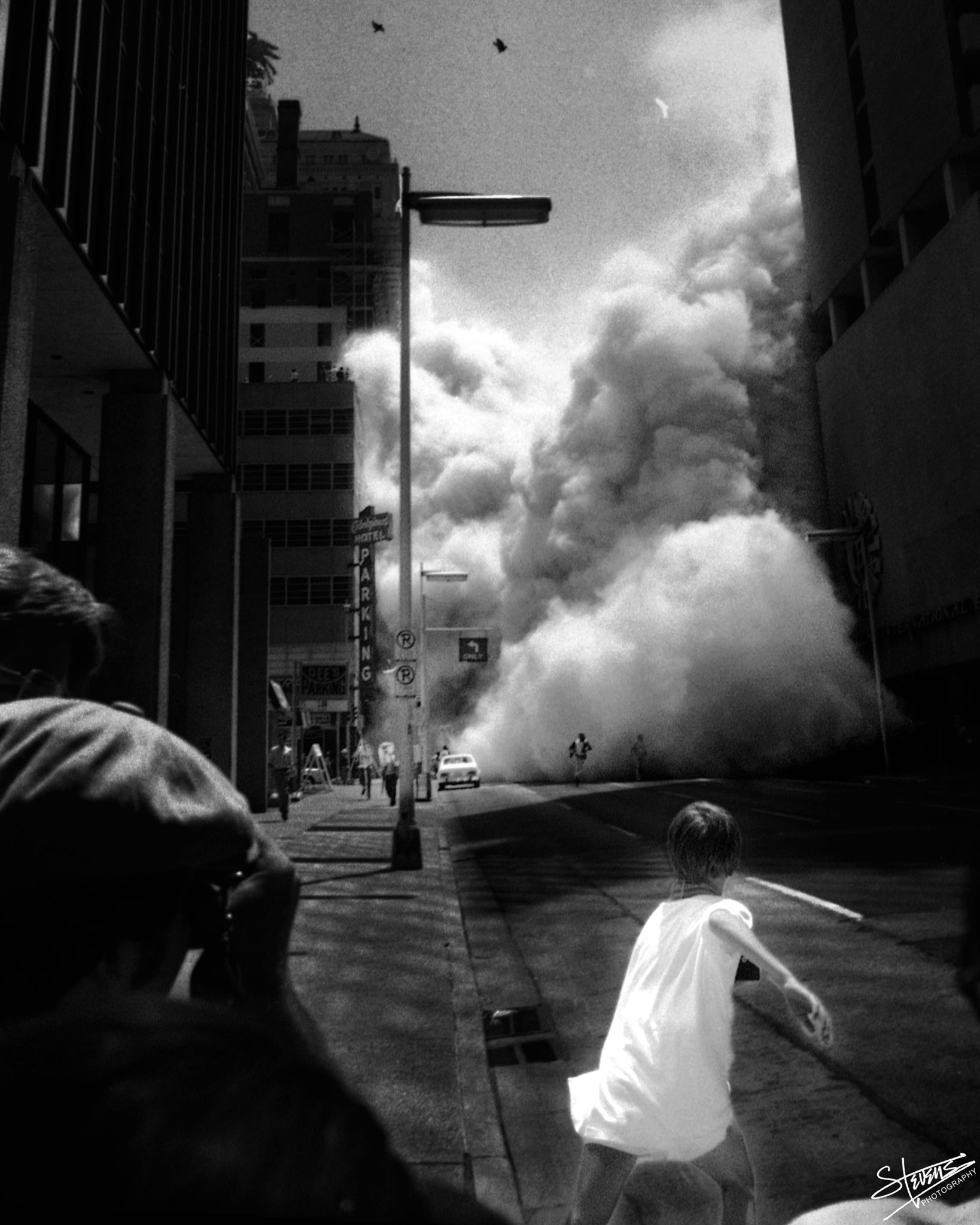The Baker Hotel Implosion: Commerce Street, 1980
A Dust Cloud, a Boy, and One Unforgettable Frame

I’d walked past the Baker Hotel for years without ever stepping inside. Back in high school it was simply background architecture — the big sentinel on Commerce Street we used as a landmark during Texas‑OU weekends when both fan bases drifted downtown. Then the headlines appeared: the Baker had been stripped for salvage and sold for demolition. On Saturday morning, June 29, 1980 it would be dropped into its own footprint. Suddenly the hotel’s coordinates — Commerce at Akard — lodged in my head like an address I’d once called home.
I wanted to witness the implosion, but more than that, I wanted to photograph it. I packed two cameras that lived at opposite ends of the timeline. Around my neck hung my brand‑new Canon A‑1 — sleek, black, and ready for as many frames as my thumb could advance. On the tripod rode a very different prize: a Model 2A Folding Autographic Brownie I’d paid $125 for at a flea‑market stall in 1979. The bellows smelled of dust and leather polish; a stylus slot along the film back promised I could etch notes onto the negative itself. The Brownie took 116 roll film, long discontinued, so I persuaded a roll of 120 to fit and prayed light leaks would stay polite.
I still wonder what became of that kid. Firefighter? War photographer?
I hope he kept the print he risked dust‑lung to capture.
I reached Commerce Street two‑and‑a‑half hours early. Police had braced wooden sawhorse barricades a dozen yards from the hotel’s north face. I planted the tripod behind the front rail, framed the Brownie, then raised the Canon to test exposures. The morning sun climbed past the skyline and burnished the cornice in warm light — so lovely I almost forgot the building was scheduled to collapse.
Spectators arrived in waves: first curious families with Polaroids, then news crews with aluminum tripods, then last‑minute thrill seekers certain the only real view was directly in front of my lens. Every shove nudged the Brownie’s legs; I kept kicking them back into alignment. The Canon, swinging free in my hands, stayed on target only because I could pivot with each nudge. Claiming a spot, I realized, is a matter of patience more than muscle.
Just after 8:30 a.m. that Saturday morning, a siren sliced the air. Window charges popped like camera flashes. Heavier booms cascaded down the core, and the Baker folded inward — graceful as a circus tent closing on itself. A yellow‑beige cloud billowed into Commerce Street, slow but relentless. Most spectators reeled back. One boy — twelve, maybe — sprinted forward instead. His dad’s 35 mm SLR bounced on his neck strap as he charged the dust, his white T‑shirt shining like a flare. I squeezed the Canon’s shutter, thumbed the advance lever, squeezed again — firing frame after frame while the crowd behind me shrank away as if the cloud could swallow them whole.
The Brownie, set to a modest ¹⁄₃₀ second, managed a single blurred exposure before the jostling made further use of it impossible. But the Canon’s Tri‑X strip emerged crisp in the developer that night. Mid‑roll, one frame stopped me cold: the boy mid‑stride, shirt glowing, arms pumping toward the ocher haze. I dodged around his silhouette with a cardboard mask I'd cut so very precisely to keep the cotton bright, then burned the surrounding dust until its edges felt gritty enough to taste. Courage, chaos and curiosity — all in one click.
The Baker was gone in thirty seconds. Its lot now hosts AT&T’s glass‑and‑granite tower — part mid‑century curtain wall, part corporate brutalism. Pedestrians pass without knowing chandeliers once glowed there. Of the Baker siblings, only the Mission‑style hotel in Mineral Wells still stands, its revival bones inching toward new life.
That photograph reminds me why we lift a lens — to hold confusion steady long enough to find the bravery hiding inside it. Preparation matters: arrive early, brace the tripod, know your gear. But decisive moments belong to those who move against the grain: the boy who sprinted forward, the photographer who refused to budge.
I still wonder what became of that kid. Firefighter? War photographer? I hope he kept the print he risked dust‑lung to capture. Whenever I pass the AT&T tower, I see the beige cloud rising, hear the crowd gasp, feel the tug of a white shirt slashing through swirling debris. Then I remember to keep a camera ready — because sometimes history happens in half a minute, and the bravest soul in the frame isn’t the one behind the shutter.
— Lawrence


